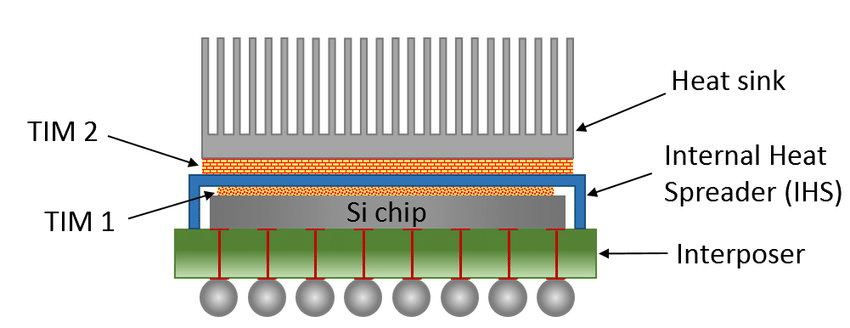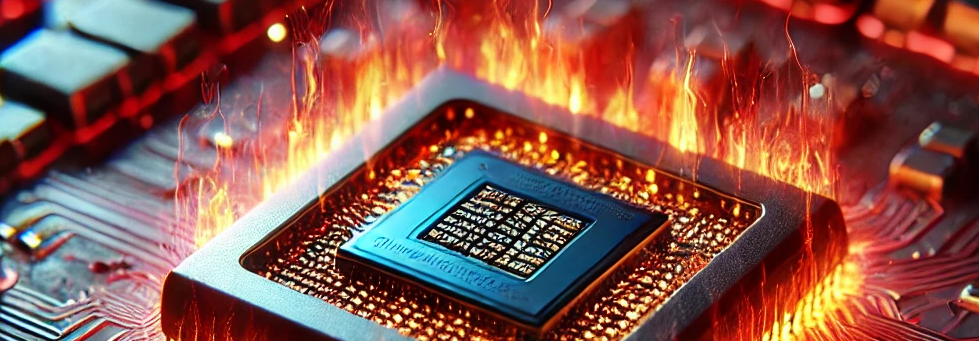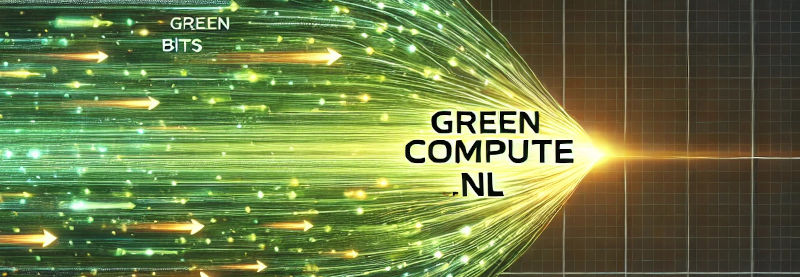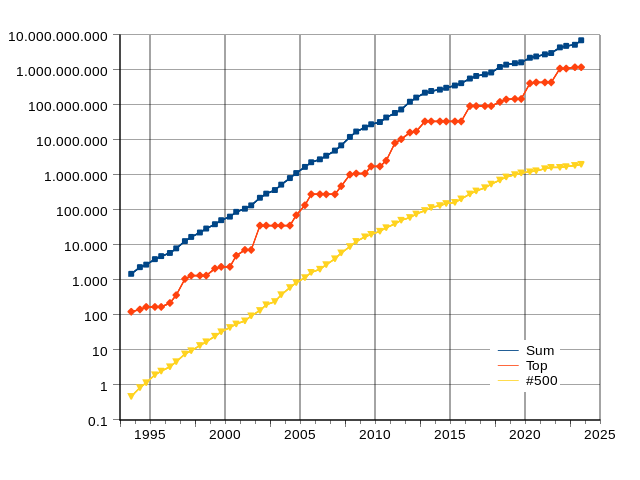Blog
This is the place where we write short blog posts to share our enthusiasm about topics that might also be interesting to you.

tech: Delidding the CPU
2024 Aug 12 - GreenCompute.nlI recently came across an intriguing video by der8auer EN on YouTube, where he delidded a CPU to achieve direct cooling of the CPU die. This process led to an impressive 13-degree Celsius reduction in temperature.
A CPU is composed of multiple layers, each adding a degree of thermal resistance that makes it more challenging to dissipate heat from the CPU die. One significant layer is the Integrated Heat Spreader (IHS), which serves as a standardized interface for various cooling solutions. While the IHS is beneficial in ensuring compatibility and protecting the die, it also introduces additional thermal resistance.
By removing the IHS layer, as done in the delidding process, the temperature difference required between the CPU die and the coolant to extract the same amount of heat is reduced. This results in more efficient cooling and, consequently, lower operating temperatures.
In our Cloud Unit, the decision to delid a CPU is a careful balance between cost (since delidding voids the warranty) and maintenance considerations, and the potential thermal benefits. Fortunately, GPUs do not include an IHS, allowing them to be cooled directly on the die for more effective heat dissipation.
Currently, we are very satisfied with the cooling performance of our CPUs without delidding. However, delidding might be an option for customers who require the absolute maximum in cooling efficiency.

tech: Workstation, Phones and Servers are heaters (that also compute).
2024 Aug 12 - GreenCompute.nlThe Cloud Unit is more than just a powerful AI machine. It's also an innovative source of sustainable energy. But how does it work, and what makes it so efficient? To understand this, let's explore the fundamentals of energy transfer and computing.
According to the first law of thermodynamics, energy cannot be created or destroyed, only transferred or transformed. In the context of computing, electrical energy is primarily transformed into heat.
At its core, computing is about moving electrical charges - specifically, electrons - through circuits. When a CPU or GPU processes data, it essentially shuttles these electrons around to perform operations like AND and OR. This movement of charge is what enables computers to perform tasks.
However, here's the crucial point: heat is generated because the electrons encounter a resistance during its journey. The power dissipation (P) can be calculated using P=I^2*R. Where I is the movement of charge and R the resistance. Even superconductors produce some heat because the have a tiny R.
This is where the cloud unit offers a game-changing solution. Instead of letting this waste heat go to, well, waste, the cloud unit captures and repurposes it. The heat generated by computing can be harnessed and offered to customers for various uses - central heating, hot water for showers, washing, and more.

news: Why the name change?
2024 Aug 04 - GreenCompute.nlOutdoorCompute.nl aimed to address the question: how do we offer the most sustainable and cost-effective cloud? The solution lies in our innovative Cloud Unit (aka Micro Data Center), powered by local green energy and reusing waste heat. However, this technical explanation often confused new customers.
With greencompute.nl, our main focus is to deliver truly sustainable and green computing power. The technical details are less important; we offer two solutions:
- Cloud-Plugin: Enhance your existing cloud, such as AWS or Azure, into a truly green and cost-effective cloud.
- Local Green Cloud: Use your existing hardware or order our high-performance servers. We'll make them immersion-ready and integrate them into the Cloud Unit.
For example, a rapidly expanding market involves running AI inference tasks on local business data. Our green cloud is perfect for this. Data is valuable only if it provides useful insights. With our Cloud, your data remains on-premise while generating continuous new insights through AI in a secure, sustainable, and cost-effective manner. This approach makes much more sense with greencompute.nl.
If you know an enthusiastic individual within a B Corp-type organization looking to leverage AI, please connect us. Thank you!

tech: How many FLOPS does a Cloud Unit has?
2024 March 27 - GreenCompute.nlWhat are FLOPS?
FLOPS is a measure used to quantify the performance of a computer's ability to perform floating-point calculations. FLOPS helps in evaluating and comparing the computational power of processors, supercomputers, and entire computing systems. Higher FLOPS ratings indicate a system's greater capacity to handle complex mathematical calculations, making it a crucial benchmark in the advancement of computing technology.
FLOPS Prefixes:
- 1 ExaFLOPS = 1,000,000,000 GigaFLOPS
- 1 PetaFLOPS = 1,000,000 GigaFLOPS
- 1 TeraFLOPS = 1,000 GigaFLOPS
Are FLOPS useful?
The FLOPS metric can only be reliably used to compare CPU performance if the same method is used to determine the FLOPS. FLOPS only measures a specific set of operations and more metrics like random string sorting, data encryption, compression, sequential or random I/O are needed to get a clear picture of CPU and server performance. The server performance depends on many factors like type of workload, cluster architecture, cache size, memory bandwidth and CPU features. But FLOPS can be useful to get a rough indication of the CPU's processing power.
OutdoorCompute focuses on Power Usage Effectiveness and Energy Reuse Effectiveness. That is why the number of FLOPS per watt is a useful metric for us, to get a rough indication of the power effectiveness.
Are all FLOPS the same?
No, you need to be very careful when comparing CPUs by the number of FLOPS. For example, the IEEE 754 standard uses the single-precision (32-bits) or the double-precision floating points. Depending on which method is used the FLOPS metric can differ a lot. Only the result of the same benchmark tool can used to compare CPUs.
Let us get the FLOPS for the AMD EPYC 7313 from different sources:
- Microway.com rates the theoretical Peak Performance in FLOPS on 750 GigaFLOPS (double-precision 64-bit).
- CPUBenchmark.net has collected 19 benchmarks and assigns 82 GigaFLOPS.
For the Microway.com I could not find the formulas how they calculated the FLOPS but the Benchmark.net uses the following method to benchmark the FLOPS for a CPU:
"The Floating Point Math Test performs the same operations as the Integer Maths Test however with floating point numbers, using an equal amount of single precision (32-bit) and double precision (64-bit) values. A floating point number is a number with a fractional part (i.e. 12.568). These kinds of numbers are handled quite differently in the CPU compared to Integer numbers as well as being quite commonly used, therefore they are tested separately. This tests uses memory buffers totaling about 240kb per core and uses an instruction mix of 30% addition, 30% subtraction, 30% multiplication and 10% division."
The FLOPS capability of GPUs is considerably more elevated compared to CPUs, but it's essential to understand that these metrics are not directly comparable due to the fundamentally different use cases each serves.
Supercomputers
To get an idea of the FLOPS range, supercomputers are now able to process more than 1 ExaFLOPS which is equal to 1,000 PetaFLOPS. This is not achieved by a single server but thousands of high performance servers. For example the Frontier cluster has over 8 thousand 64-core EPYC 64C processors in its cluster resulting in a performance of 1,194 PetaFLOPS.

Servers
The key insight from this section is that choosing the best CPU for the Cloud Unit hinges on a variety of considerations. These include initial purchase and ongoing variable costs, efficiency metrics such as FLOPS per Watt, and reliability. Although newer CPU generations offer enhanced efficiency, they also tend to incur substantially higher costs per FLOP.
The Snellius supercomputer of the Netherlands (8.2 PetaFLOPS) uses mainly the AMD EPYC 9654 and 7H12 CPUs in its cluster. For the compute flavored Cloud Unit we use the lower count core CPUs like the AMD EPYC 7313P because it is most suitable for Function as a Service (FaaS) workloads at this moment. But for specific customer use-cases we will determine the optimal CPU to use.
Lets compare using the CPUbenchmark.nl FLOPS metrics:
Generation CPU cores GigaFLOPS TDP Number of servers Total TeraFLOPS GigaFLOPS/Watt
AMD EPYC 9654 4e (2022) 96 ~488 360W 7 3.42 1.36
AMD EPYC 7763 3e (2020) 64 ~293 280W 9 2.64 1.06
AMD EPYC 7H12 2e (2018) 64 ~238 280W 9 2.14 0.84
AMD EPYC 7313P 3e (2020) 16 ~80 155W 16 2.35 0.94
AMD EPYC 7282 3e (2019) 16 ~58 155W 20 1.16 0.94
And the Microway.com FLOPS metrics (theoretical):
Generation CPU cores GigaFLOPS TDP Number of servers Total TeraFLOPS GigaFLOPS/Watt
AMD EPYC 7763 3e (2020) 64 ~2500 280W 9 22.5 9.00
AMD EPYC 7313P 3e (2020) 16 ~800 155W 16 12.8 5.12
AMD EPYC 7282 2e (2019) 16 ~750 120W 20 15.0 6.00
Costs of servers in the Cloud Unit:
CORES Number of servers CPU cost Total CPU cost
AMD EPYC 9654 96 7 $6,690.- $50,830.-
AMD EPYC 7763 64 9 $2,494.- $22,446.-
AMD EPYC 7H12 64 9 $3,719.- $33,471.-
AMD EPYC 7313P 16 16 $900.- $14,400.-
- Number of servers is based on the maximum power consumption of 5kW per Cloud Unit.
Latest CPU generation
The latest generation of CPUs have a higher FLOPS/Watt due to new innovations regarding the microarchitecture and production process. For example the Zen 4 microarchitecture can execute 18% more instructions per clock cycle compared to the Zen 3 microarchitecture.
Using the latest CPU architecture will lower the variable expenses but increase the initial investment. This could make sense depending on the investment horizon. And financial compensation for providing heat.
Higher or lower number of CPU cores?
The CPU core systems with a high amount of cores (64) have around ~10% more FLOPS per Watt, but require a significant initial investment. And other metrics that where out of scope in this blog post like storage I/O, RAM bandwidth will be much better performing on lower core count CPUs.
The higher amount of cores also means that the Thermal Design Power (TDP) will higher. ~400 Watt for 96 core and ~200W for a 16 core CPU. But that is not an issue because we use liquid immersion cooling, the Cloud Unit can support a TDP up to 1000 Watt. The improved heat transfer rate that is caused by this cooling method could boost the performance of the CPUs with +30% (AMD EPYC core performance boost).
Last major point is reliability. Higher core count per CPU means that for the same amount of FLOPS less servers are needed. Which means that if 1 server fails a large part of the compute power will not be available (96 core = 20%, 16 core = 6.25%). That is why for the Function as a Service (FaaS) use-case which executes many small tasks we use a CPU with a lower core count.
Conclusion
We can install any type and amount of CPUs into the Cloud Unit as long as the total amount of power is within the maximum power specification of 5KW. In general, installing the most powerful and latest CPUs will increase the amount of FLOPS with ~20%. But will have a major impact on the initial investment and could have a negative impact on the overall performance (depending on the use-case).
So now we can answer the question, how many TeraFLOPS does the Cloud Unit has? Again it depends on the benchmark tool or method used to determine the FLOPS:
- Microway.com: One Cloud Unit can house 7x AMD EPYC 9654 and will produce 22.5 TeraFLOPS.
- CPUbenchmark.nl: One Cloud Unit can house 7x AMD EPYC 9654 and will produce 3.4 TeraFLOPS.
Excluding the core performance boost by using liquid immersion cooling.
You can apply the same calculation method to determine the FLOPS using other benchmark tools or methods:
- FLOPS per Cloud Unit = 5000W/((2*TDP) * FLOPS per CPU) + 12%
- FLOPS/Watt per Cloud Unit = (5000W/((2*TDP) * FLOPS per CPU) + 12%) / (TDP * (5000W/((2*TDP))
+12% is the assumed AMD Core Performance Boost due immersion cooling.
Feedback & Questions:
Did you found a mistake, have another opinion or want to talk about the capabilities of the Cloud Unit? Please contact me at nick@outdoorcompute.nl.
Sources:
tech: Edge computing trend
2024 March 08 - GreenCompute.nlHistory Edge Computing
Edge computing, a concept originating in the 1990s, aims to bring computing closer to end-users. Initially utilized as Content Delivery Networks to reduce network transit and load times for videos and websites.
The term Cloudlets was coined around 2009, focus primarily on addressing latency issues. Traditionally, apps or websites run on devices connected to distant powerful clouds containing data and processing power. However in "fog computing", many cloudlets are deployed within the same region, extending the cloud and bringing it closer to the end-user, enhancing the responsiveness of apps and website. Technologies requiring real-time low-latency, such as 5G, Industry 4.0, augmented reality, and IoT, significantly benefit from cloudlets.
Modular Integrated Sustainable Data Centers (MISD, coined 2023) share similarities with cloudlets but emphasize sustainability. They incorporate elements such as heat reuse, electricity net dynamics, and efficient distributed computing.
Current and future challenges
The strain on electricity grid is increasing due to ongoing electrification, while the demand for cloud services is growing rapidly. Concurrently, the shift towards sustainability and a circular economy presents already significant challenges. These trends have a positive effect on our society and the environment but present major challenges.
Nonetheless, it's inspiring to witness the variety of solutions emerging, for example high-density energy storage, novel solar panels, heat isolation techniques, smart systems, recycling initiatives, and innovative heat extraction mechanisms. Enumerating all researchers and organizations in this blog post would be exhaustive and will require a separate blog post.
Solution in cloud industry
To address these challenges in the cloud industry, smart and efficient systems are imperative. Numerous researchers and innovative organizations are developing solutions, each with its unique approach. To accelerate innovation in MISD-related solutions, the European Union has invested 1.2 billion euros in research support.
We firmly believe that our society will inevitably transition to full sustainability and circularity. Our Cloud Unit represents a significant stride towards making the cloud industry not only sustainable but also environmentally friendly. It goes beyond being just a Modular Integrated Sustainable Data Center; we offer a comprehensive Cloud Service compatible with most cloud providers. By instantly converting existing cloud environments into sustainable and cost-effective ones, we are pioneering a shift towards a greener cloud ecosystem.
We envision a world where the cloud seamlessly integrates into society, creating value for businesses by reducing cloud costs and enabling consumers to directly reuse waste heat. Furthermore, we invite everyone to invest in our expanding cloud network of Cloud Units, contributing to a more sustainable future for all.
